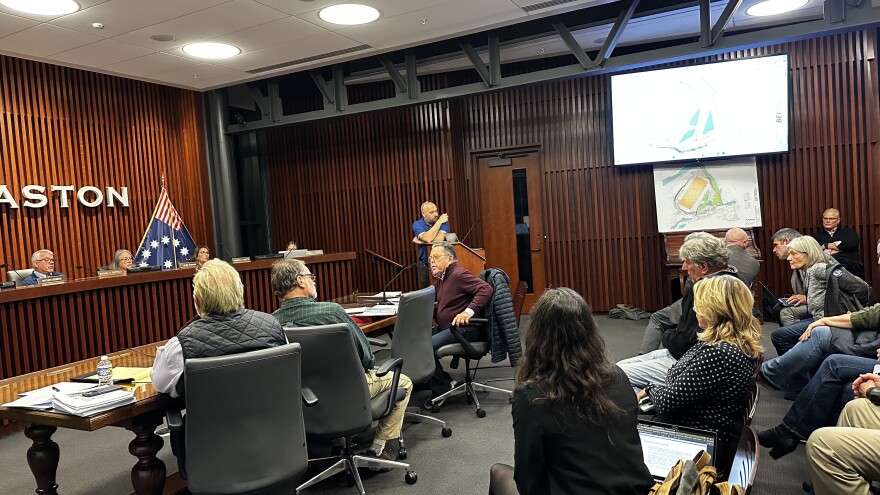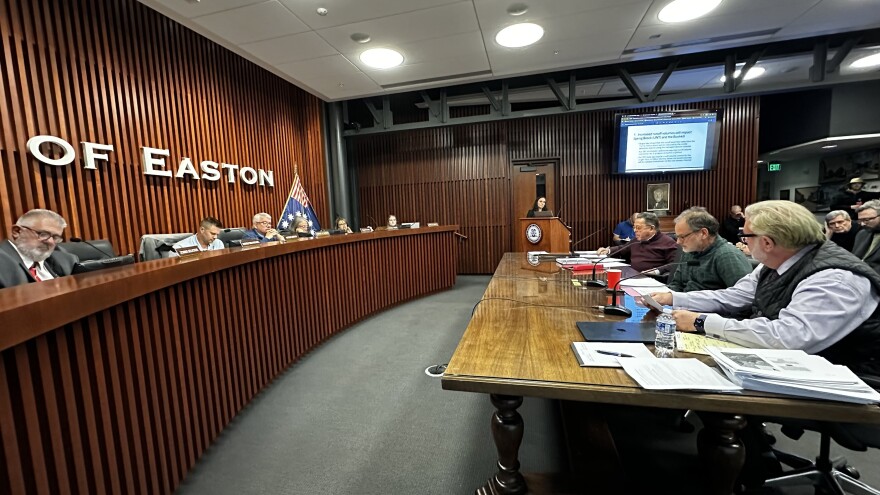EASTON, Pa. — A proposal to relocate a tributary as part of the massive Easton Commerce Park project could worsen flooding and environmental damage, an engineering expert warned Monday.
Easton's Zoning Hearing Board held a special meeting dedicated to the movement of a tributary on the Easton Commerce Park site.
Over four hours, opposition to the project called one expert witness to challenge the validity of the permits awarded to developer Scannell Properties.Monday public hearing
Over four hours, opponents to the project called one expert witness to challenge the validity of the permits awarded to developer Scannell Properties.
Mostly in Wilson Borough, the property at 1525 Wood Ave. — the former Pfizer Pigments plant — is proposed to become the site of a 1-million-square-foot warehouse.
Attorney Edward P. Shaughnessy called Lafayette College civil and environmental engineering professor David Brandes to contest information and studies used by Bogia Engineering to get permits from the state Department of Environmental Protection and other agencies.
And those alleged miscalculations could lead to increased flooding, Brandes said, impacting the site, the surrounding areas and the wildlife and vegetation nearby.
Data questioned
Brandes said using Bogia’s data in a runoff model showed that a 10-year storm (4.56 inches over 24 hours) would produce an additional 6 million gallons of water.
A 100-year storm (7.44 inches over 24 hours) would produce over 10 million gallons for the modified wetland, Brandes said.
Brandes also said Bogia used estimates in its calculations that rely upon a simplified scaling method, which did not account for different watershed characteristics, including higher runoff potential in Spring Brook and the impact of quarry discharges on the Bushkill Creek flow.
By using StreamStats, a program for water resource planning and management, Brandes said Bogia failed to take into account the small size of the Spring Brook watershed — around 2.3 miles — which required them to extrapolate a figure that fell outside the model’s parameters.
Later in the meeting, Brandes said the smallest watershed used in the study tapped by Bogia was 19 square miles, substantially larger the Spring Brook Watershed.
To get more accurate information, Brandes said a runoff model for the Spring Brook watershed should have been conducted, taking into account the 100-year storm figure, information based on actual land uses, soil types and flow paths into the watershed.
It also should have used a stream gauge to acquire real data from the site and more.
'Underdesigned'
The proposed move of Spring Brook would be insufficient for the conditions it could potentially see, Brandes said. He described those flows as “quite a bit higher than this little equation would estimate.”
“We want to have high confidence that we've got a properly designed channel. And my contention is that the way that these equations were used is invalid and likely results in an underdesigned channel.”Lafayette College Civil and Environmental Engineering Professor David Brandes
“So I think the importance is that this is a complex site," he said. "We're relocating a stream channel. We're putting water in that channel from upstream and from a site with 54 acres of imperviousness.
“We want to have high confidence that we've got a properly designed channel. And my contention is that the way that these equations were used is invalid and likely results in an underdesigned channel.”
Brandes also questioned soil classifications on the site, with existing site soil potentially producing higher runoff rates on the property with stormwater.
Brandes said flawed information put into the U.S. Army Corps of Engineer’s Hydrologic Engineering Center's River Analysis System study was essentially invalid.

“I don't have any confidence that the answers that it gives are correct," he said. "I think a calibrated runoff model would have been a much better approach.
“And so what this means, I've been saying that already a number of times, if that channel is underdesigned, we're going to have more overbank flows and more localized flooding, because that channel is not designed to contain the flows that are likely to be coming downstream.”
Cross-examination
Attorney Marc Kaplin, representing the developer, challenged Brandes’s findings. Kaplin said Brandes had not investigated the site as it currently stands.
“So you don't know whether that stream that flows there now and will flow afterward is creating so much water that there are flooding conditions now," Kaplan said. "You don't know that."
“I was hired by Ed [Shaughnessy] to review these documents, and that’s what I did, and I gave my expert opinion on it.”Lafayette College Civil and Environmental Engineering Professor David Brandes
Brandes responded that his reasonable estimate was the conditions present at the time could produce flooding during high rainfall.
Kaplin also questioned Brandes about a culvert under Hackett Avenue — which might not be sufficient to hold excess water. He said the professor hadn't conducted studies on site.
He also asked why Brandes had not provided concerns to the DEP during NPDES permitting.
Brandes responded, “I was hired by Ed [Shaughnessy] to review these documents, and that’s what I did, and I gave my expert opinion on it.”
Kaplin spent additional cross-examination time trying to show all requirements for movement of the tributary had been met, as the Scannell had acquired necessary DEP and Army Corps of Engineers permits.
However, city solicitor Robert Nitchkey pointed out that meeting the requirements of those permits does not clear the developer for any special exceptions in Easton.
To be continued
Nitchkey asked Brandes directly if the proposed tributary movement would violate any Easton zoning regulations, such as the prevention of significant possibilities for pollution, increase flood levels and potential damage to life and property.
"Yes," Brandes responded.
Following public comment — including statements from Trout Unlimited’s Bruce McCutcheon and several others arguing against the special exception and the entire project — Bogia Engineering’s Donald Haas took to the podium to address some of Brandes’s testimony.
Haas first challenged Brandes’s statement that the moved tributary would be subject to flooding conditions.
“Our site is very close to the point that's analyzed," Haas said. "It drains quicker than another point, half mile upstream, and it's going to take some time to get there.
“So what you get is different peaks during a storm where some flow will immediately come off, create a peak.
He said the culvert under Hackett Avenue, which is set to be replaced, also would help with rate control, and assist with restrictive flow.
The meeting was cut off at 10 p.m. It will be continued at a time and date to be set.


